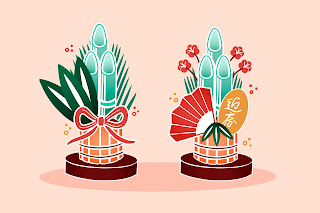Decors of Japanese New Year
Decors of Japanese New Year
 |
| Image by pikisuperstar on Freepik |
New Year's is an important occasion in Japan, with many traditional decorations. These decorations are intended to bring good fortune and luck to the household for the forthcoming year. The following are some of the most common decorations seen during the Japanese New Year:
Kadomatsu (traditional Japanese New Year's decorations) are composed of bamboo, pine, and other materials. They are typically set in pairs outside the front doors of homes and businesses to greet the New Year gods and bring prosperity and longevity.
Shimekazari - Rope decorations constructed of straw, shimenawa (sacred rope), and other materials. They are hung above the doors of houses and businesses to ward off evil spirits and welcome the gods of the New Year. Shimekazari designs can vary, but they usually include auspicious symbols like pine needles, rice straw, and citrus fruit.
Kagami Mochi - It is a traditional New Year's decoration that consists of two circular rice cakes of varying sizes placed on top of each other and topped with a citrus fruit, such as a mandarin orange. The rice cakes signify the past and the future, while the citrus fruit denotes good fortune.
Daruma Dolls - These are traditional Japanese dolls that depict the founder of Zen Buddhism, Bodhidharma. They are usually red and spherical in appearance, with no arms or legs. Daruma dolls are frequently given as New Year's gifts to symbolise good fortune and perseverance.
Fukubukuro - During the New Year, several establishments sell fortunate bags loaded with surprise gifts. The contents of the bag are normally unknown, however they are frequently loaded with sweets, stationery, and tiny toys.
Ema - These are little wooden plaques on which people write their New Year's wishes and hang them at shrines and temples. The notion is that the gods will accept the wishes and grant them.
Nengajo - These are New Year's postcards sent to friends, relatives, and work colleagues. They usually include a Chinese zodiac animal for the future year as well as greetings for a happy and prosperous New Year.
These are just a few of the many traditional decorations found during Japanese New Year. They all have specific meanings and are an integral element of the holiday celebrations.

Comments
Post a Comment